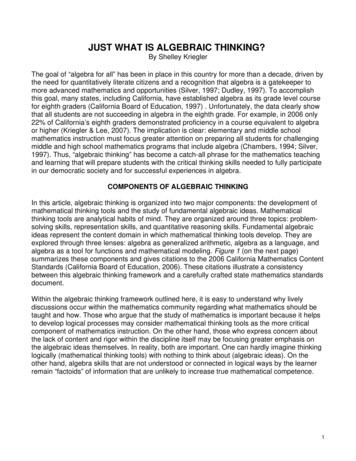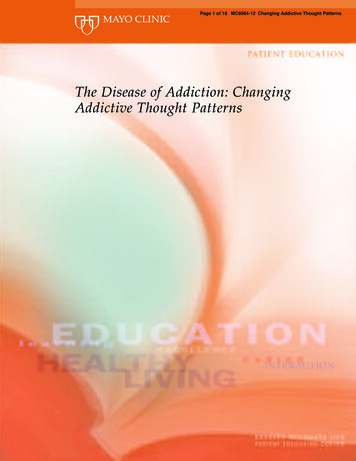
Transcription
Making Mathematical Thinking VisibleJohannah NikulaJill Neumayer DePiperMark DriscollEducational LeadershipDecember, 2019/January, 2020
MAKINGMathematicalThinkingVISIBLEFor English language learners, diagramscan be a powerful tool to develop andcommunicate mathematical understanding.Johannah Nikula, Jill Neumayer DePiper,and Mark Driscollascdmagine being a 6th grade student who is still learning English, sittingin a mathematics classroom and trying to navigate the lesson. Youmight wonder: What is the teacher saying I should do? Did my classmates solve it the way I did? Will the other students laugh at mewhen I try to explain how I solved the problem?Now imagine being a teacher in that same classroom. You might beasking yourself: What can I say so that all my students will understandwhat to work on? How do I know that all my students understand howto solve this problem? How can I help students share their mathematicalthinking in productive ways?These challenging questions are part of the hard work of mathematicsinstruction, and they are important to consider for all students. Butthey are especially pertinent to working with students who are learningASCD /www.
For these students, diagrams servedas a thinking tool, helping them tonavigate the quantities given in theirword problems and find mathematicalrelationships to help solve the problem.English. Unfortunately, students who areEnglish language learners1 too often becomeinvisible in math classrooms because they lackproficiency in English and don’t have opportunities to communicate their mathematicalthinking. It doesn’t have to be this way.For the past decade, we have studied the rolethat mathematical diagrams can play in givingELLs more productive mathematics experiences. We have collaborated with hundredsof middle-grades teachers across the countryto investigate how visual representations suchas area models, number lines, and geometricfigures are used by students and how theycan facilitate ELLs’ mathematical reasoningand communication. By making mathematicalthinking visible, we’ve found, diagrams canplay a central role in enriching mathematicseducation for ELLs.Illustrating the ProblemResearch has documented that mathematicaldiagrams can be helpful for all students andfor ELLs in particular. Mathematics instructionthat uses multiple types of mathematical representations reinforces the learning of concepts,processes, language, and norms of mathematical communication (Chval & Chávez,2011; Woodward et al., 2012). Diagrams areof particular value because they can illustrate atask’s mathematical structure and help connectthe text of a word problem to abstract conceptsor the symbolic notation for solving it (Ng &Lee, 2009). Diagrams are also useful tools forsupporting mathematical reasoning, problemsolving, and communication. Furthermore,78E d u ca t i o n a l L eade r s h i p / D ece m b e r 2 0 1 9 / J a n u a r y 2 0 2 0diagrams are a way that teachers and classmatescan see and hear what ELLs are thinking anddoing in their math work, thus positioningELLs as active participants in mathematicslessons (Driscoll, Nikula, & Neumayer DePiper,2016).To illustrate how diagrams can facilitate andmake visible ELLs’ quantitative reasoning andmathematical communication, we offer threeexamples drawn from work by students we’veobserved.Jan, a 6th grade ELL, worked on the following task: “Maureen bought 4 bags of soilfor her gardens. Each garden needs 3/4 of abag of soil. How many flower gardens can shefill?”2 She drew a diagram (Figure 1)3, and thenexplained it: “First, I drew the 4 bags then I cutthem into fourths. I shaded in three for eachone and circled it. That’s one garden. That’stwo gardens, that’s three gardens, that’s fourgardens, and that’s five gardens. So, she can fillcompletely five gardens and she will have 1/4 ofa bag left over.”FIGURE 1. Jan’s Diagram of theFlower Garden TaskNote that mathematical relationships areprominent in Jan’s diagram and explanation.Her work presented a repeated subtractionapproach to division, subtracting 3/4 repeatedlyfrom the four bags, and counting the totalnumber of times she can count 3/4 from thefour whole bags. The diagram helped her tokeep track of the quantities and relationshipsbetween quantities. In this sense, we can saythat the practice of diagraming supported Janin becoming more proficient in the mathematical practice of reasoning quantitatively andabstractly—a key mathematical practice under
the Common Core standards (NGA & CCSSO,2010).Sam, another 6th grade EL, took a different approach with his diagram on the sameproblem:FIGURE 2. Sam’s Diagram of theFlower Garden Taskcounted in Spanish, “Uno, dos, tres. . . .”Carmine and Luis also had a set of printedcards with sentence starters such as “Thisdiagram shows . . .” and “I like this diagrambecause . . .” to help them structure explanations during their pairs work. Using thesesentence starter cards, the students explained,“This diagram shows 12 jumps,” and “I like thisdiagram because I see all the one-thirds.”FIGURE 3. Number line for the task,4 1/3He explained: “I made four flower gardens,and I divided by fourths. Then I shaded in 3/4of a garden because [. . .] the four boxes represent the fourths and the part that’s shadedin represents the 3/4.” When the teacherasked where the fifth garden came from, Samresponded: “When I shaded in with 3/4 in eachgroup, I found there was 1 left over in eachgroup because I used all the 3/4 I could find. Itook the 3/4 from the three other groups andmade them into one group and I know therewas one left over.”While Sam mistakenly said “I made fourflower gardens,” he correctly labeled his fourrectangles as “bags of soil,” and was able to usethe diagram to link quantities in the task tomathematical operations needed for a solutionby attending to the mathematical structure ofthe problem, another key mathematical practiceunder the Common Core standards (NGA &CCSSO, 2010).In another classroom, two 6th grade ELLs,Carmine and Luis, worked on a word problemfor which they needed to figure out what 4 1/3 equals. The students used a number line(Figure 3), and as they proceeded, Carminepointed at the line, using her finger to showjumps for each 1/3, starting at 0 and moving herfinger closer to 4 with each jump, while LuisIn this case, the diagram, in combinationwith their use of their first language to supportthinking through a problem and sentencestarters to frame their mathematical explanations, facilitated the students’ conceptualizationof the task and provided the teacher a clearrepresentation of their thinking.Supporting Sensemaking in MathematicsFor Jan, Sam, Carmine, and Luis, diagramsserved as a thinking tool, helping them tonavigate the quantities given in their wordproblems and find mathematical relationshipsto help solve the problem. Diagrams can beinstrumental in facilitating this kind of sensemaking and the selection and modification of asolution strategy (Ng & Lee, 2009).Of course, we also want students to acquireand use the various forms of algebraic representations, but it is possible to build towardsuch representations using diagrams. One ofthe research-based recommendations for mathinstruction is to teach students how to use diagrams, which can make them more effectiveproblem solvers, rather than just focusingon algebraic representations (Woodwardet al., 2012). By focusing on diagrams before,or in addition to, algebraic representations,students have more opportunities to engage inASCD /w w w . ascd . o r g79
mathematical thinking.Diagrams represent the critical mathematicalcontent—for example, fraction division inthe examples above—and they call students’attention to the quantities given in a problem,as well as the relationships between quantities. Diagrams can also provide a structurefor understanding a term, phrase, concept,or problem context because they can link thewords that set out a problem with the calculations that move toward a solution. In this sense,they can provide an important bridge whenstudents struggle with the words-to-symbols-tonumbers transitions.As a tip for teachers, we have also found inour work that diagrams don’t have to be createdby the students to serve as powerful referentsBy focusing on diagrams before, or inaddition to, algebraic representations,students have more opportunities toengage in mathematical thinking.for mathematical thinking. Intentionally chosenor designed diagrams, or fictitious student workthat presents one way of solving a task withoutsuggesting it is the only method, can alsoencourage student reasoning and expression(Booth et al., 2013).Supporting Student CommunicationIn addition to supporting students’ sensemaking, diagrams can facilitate mathematicalcommunication and language development.To meet ELLs’ needs, math teachers must usepractices that “specifically address the languagedemands of students who are developing skillin listening, speaking, reading, and writing in asecond language while learning mathematics”(Celedón-Pattichis & Ramirez, 2012, p. 1).We have found that integrating mathematicaldiagrams into instruction—by having studentsboth create them and analyze ones that othershave created—provides students artifactsthey can use to talk about the mathematical80E d u ca t i o n a l L eade r s h i p / D ece m b e r 2 0 1 9 / J a n u a r y 2 0 2 0 Through our work with ELLs, we’ve seenhow students’ diagrams help communicate therichness of their mathematical thinking. Diagrams help them showcase their mathematicalthinking to the teacher and other students,without having to rely only on words or havingto know the “correct” words. In this manner,diagrams promote student agency and mathematical authority. For Jan, Sam, Carmine,and Luis, all of whom have low-intermediateor beginner English-proficiency levels, theirdiagrams were resources for communicatingtheir thinking in addition to serving as tools tosupport thinking.As shown in the example of Carmine andLuis above, ELLs can benefit from specific language supports integrated with diagram use.Sentence starters, in particular, can help elicitstudent explanations about their diagrams. Inproviding structures for students’ writing andspeaking, sentence starters can focus students’attention on specific mathematical relationshipsin a diagram and encourage students to communicate their thinking and sometimes to useacademic language they may not otherwise use(Driscoll, Nikula, & Neumayer DePiper, 2016).Facilitating Engagementand GrowthTo summarize, based on our research, our keyrecommendations to educators for supportingELLs’ engagement in mathematical reasoningand communication are:n Encourage diagrams as mathematicalproblem-solving tools, to engage ELLs in production of mathematical explanations, and tosupport your analysis of their mathematicalthinking.n Facilitate analysis and discussion of diagramsby students to support ELLs’ mathematicalcommunication and their understanding ofproblem-solving approaches.n Integrate language supports such as sentencestarters into mathematical tasks to increaseELLs’ access to tasks and their communication
about their mathematical reasoning.Our work with mathematicsteachers and their students hasshown us that using diagrams inthis way builds ELLs’ mathematicalreasoning, communication, andproblem-solving skills, and increasesoverall task engagement. Further,diagrams can provide teacherswith critical information about students’ mathematical understanding(Driscoll, Nikula, & NeumayerDePiper, 2016).Perhaps most important, diagramsprovide a means for ELLs to be fulland engaged participants in classeswhere they might otherwise beoverlooked or neglected. ELAuthors’ note: The research reported inthis article was supported by the Instituteof Education Sciences, U.S. Department ofEducation, through Grant R305A170297and by the National Science Foundationunder Grant DRL-1503057, both underEducation Development Center. Anyopinions, findings, and conclusions orrecommendations expressed are thoseof the authors and do not necessarilyrepresent views of the Institute, the U.S.Department of Education, or the NationalScience Foundation.1Note that in this article we referto students who are learning Englishas English language learners for claritybecause that is how many districtsidentify them. However, we believe thatother terms, such as emergent multilingual learner, can better highlight theANTONIO DIAZ / iSTOCKThrough our work withELLs, we’ve seen howstudents’ diagramshelp communicatethe richness of theirmathematical thinking.strengths students bring to the classroomcontext.2This math task is adapted fromHughes, G., Brendefur, J., & Carney,M. (2015). Reshaping teachers’ mathematical perceptions: Analysis of professional development task. MathematicsTeacher Educator, 3(2), 116–129.3The diagrams presented in this articleare recreations of students’ work.ReferencesBooth, J. L., Lange, K. E., Koedinger,K. R., & Newton, K. J. (2013).Example problems that improvestudent learning in algebra: Differentiating between correct and incorrectexamples. Learning and Instruction, 25,24–34.Celedón-Pattichis, S., & Ramirez, N. G.(Eds.). (2012). Beyond good teaching:Advancing mathematics education forELLs. Reston, VA: National Council ofTeachers of Mathematics.Chval, K. B., & Chávez, O. (2011).Designing math lessons for Englishlanguage learners. MathematicsTeaching in the Middle School, 17(5),261–265.Driscoll, M., Nikula, J., & NeumayerDePiper, J. (2016). Mathematicalthinking and communication: Accessfor English learners. Portsmouth, NH:Heinemann.National Governors Association Centerfor Best Practices, & Council ofChief State School Officers (NGA &CCSSO). (2010). Common Core StateStandards: Mathematics.Ng, S. F., & Lee, K. (2009). The modelmethod: Singapore children’s tool forrepresenting and solving algebraicword problems. Journal for Researchin Mathematics Education, 40(3),282–313.Woodward, J., Beckmann, S., Driscoll,M., Franke, M., Herzig, P., Jitendra, A.,et al. (2012). Improving mathematicalproblem solving in grades 4 through 8:A practice guide (NCEE 2012-4055).Washington, DC: National Center forEducation Evaluation and RegionalAssistance, Institute of Education Sciences, U.S. Department of Education.Copyright 2019 Johannah Nikula, JillNeumayer DePiper, and Mark DriscollJohannah Nikula (JNikula@edc.org) and Jill Neumayer DePiper(JDePiper@edc.org) are mathematicseducation researchers at EducationDevelopment Center, where they focuson equity and broadening participation.Mark Driscoll is a nationally recognizedleader in mathematics education whohas overseen a wide range of mathematics teacher education, leadership,and materials development projects atEducation Development Center.ASCD /w w w . ascd . o r g81
ELLs’ engagement in mathematical reasoning and communication are: n Encourage diagrams as mathematical problem-solving tools, to engage ELLs in pro-duction of mathematical explanations, and to support your analysis of their mathematical thinking. n. Facilitate analysis and discussion of diagrams. b










